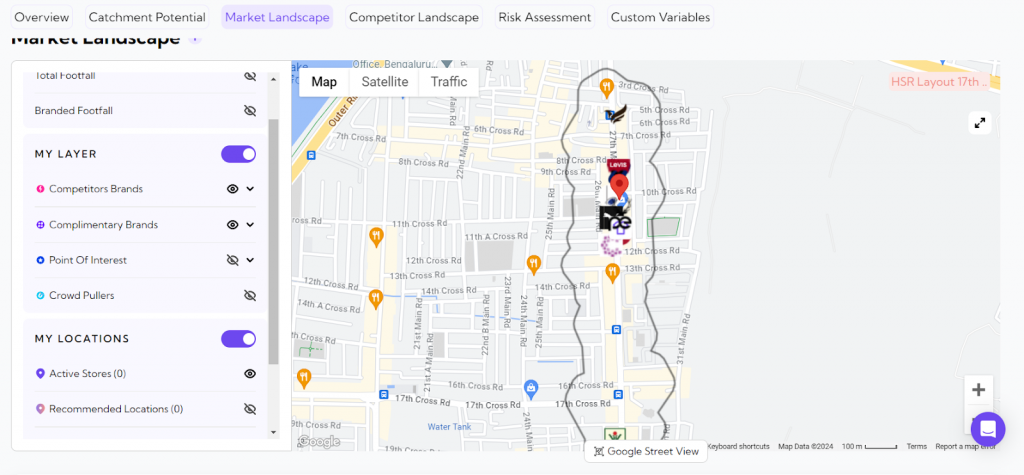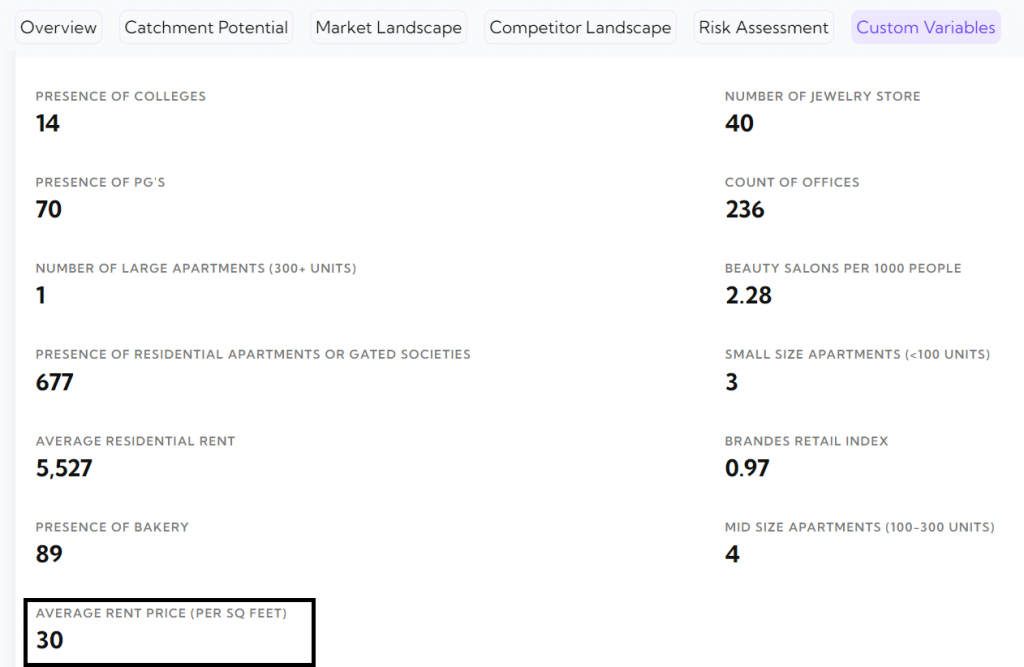Sun Tzu famously said, “Know your enemy and know yourself and never fear the result of a hundred battles.”
Competition mapping is the starting point to accurately develop a comprehensive expansion strategy for a retail business.
Competitor analysis also known as competition mapping is the strategic process of analyzing and evaluating your competitors’ strengths, weaknesses, and strategies to gain valuable insights that can inform your business decisions.
In this guide to effective competition mapping, we will help you understand how competition mapping allows,
- A brand to identify the perfect location for its retail expansion
- How a brand can improve its marketing and product strategies
Through the examples in the article, you will learn how to conduct competition mapping from scratch. You will also learn how to leverage the insights gained from the exercise to accelerate your retail growth.
What Is Competition Mapping?
In the simplest of terms, competition mapping is a method to analyze the pros and cons of a direct competitor.
For example, if you were starting a store on a busy street, you would first scope out the competition. Understand their products, their marketing, and their pricing strategies. This activity will help you develop a robust strategy to build a more resilient retail store.
The Importance of Competition Mapping in Retail
Retailers can utilize the insights gained from this exercise to strategically align their product offerings to the requirements of their customers. Below are key features that can enhance the operations of a retail store.
Product Improvements
Comparing your product with that of your competitors helps you determine the gaps within your offering.
For example, imagine if you are selling a winter clothing product, and the products offered by your competitor all have a pouch on the side, but yours does not.
Applying competition mapping helps you identify the gap present between your product and that of your competitors allowing you to incorporate the changes in the next iteration.
Marketing Improvements
Leveraging the insights from analyzing your competitors’ marketing strategies will help you craft an optimized method to tell your brand’s story to your customers.
For example, imagine you are starting a fictional apparel business on the 27th Main Road, HSR layout. Upon reviewing your competitors’ marketing strategies, you realize that there is an untapped market in directly reaching out to your target market with pamphlets.
Decode Retail Expansion

Sometimes an image is sufficient to help convey a story. In the above image, we have selected a location on the 27th main road, HSR layout, Bangalore.
Notice how there is a presence of same-category stores (fashion stores) in this location?
This indicates the presence of a high density of the target audience for the brands in the catchment area.
Applying competition mapping helps retailers reduce the number of locations they need to scout before finding that perfect spot for expansion.
How to Conduct Competition Mapping
Conducting competitive mapping is deceptive in its simplicity. There are only a few basic steps that a retailer should follow to develop an accurate analysis of its competition.
Listed below are the steps that a retailer should follow to conduct competitive mapping, made simple with an example of a hypothetical retail store.
First step: Identify Competitors
The prelude to this step is to understand the Total Addressable Market of your retail brand. Once you understand the spread of your target audience, you can then start to analyze the stores present in the catchment areas with a high density of your target audience.
Your competitors could be brands that directly compete with the products you offer. Like for instance, from our earlier image, the competitors for our apparel brand would be brands like Levis, Peter England, and others.
Or, they could be an indirect competitor. Following our previous example, for an apparel brand selling clothes, Nike or Addidas could be an indirect competitor even though the latter two brands are present in the sports category.
Once a brand has selected its competitor, it should collect information about the locations, marketing strategies, and product offerings for the next step.
Second Step: Identify Features to Compare
To develop a comprehensive map of the brand’s competitors, it should select a focus area to compare against the competition.
For example, imagine if a hypothetical brand wanted to analyze the locations of its competitors. It would have to identify all competitors present within the selected catchment area.

Third Step: Analyzing the Strengths and Weaknesses of the Brand
Now that the brand has selected the competitors and also identified the focus areas to conduct its competitor analysis, the next step is to determine its strengths and weaknesses and compare them against its competition.
Let us continue with the example of the apparel brand opening a store in Bangalore. For the sake of this example, let us consider that the apparel brand is a digitally native DTC brand with a considerable social media presence.
After reviewing the research collected from the ground business development team and its Retail AI solution partner, the brand might identify the following
Strengths
- Being present on the 27th Main Road provides the brand with high visibility and foot traffic.
- The location also enables customers to easily access the store.
- As a digitally native brand, it can leverage its large nascent customer base to develop a robust omnichannel retail experience
- The relatively large social media presence further reduces the marketing spend.
Weaknesses
- The location the brand has selected to expand into – 27th Main Road, HSR, is a prime area and attracts high rental expenses.

- The presence of a large number of the same category stores in the catchment area represents intense competition which might eat into the revenue of the brand.
- Failure to devise an enticing pricing strategy may prolong the break-even period for the brand, resulting in delayed profitability.
Fourth Step: Compare Findings with Competitors
The insights derived from identifying the strengths and weaknesses of a brand should now be compared against those of its competitors.
In our example, the retailer would select direct competitors such as Van Heusen, Allen Solly, or Peter England. By analyzing the strategies employed by these competitors, the brand gains valuable insights into potential shortcomings in its strategy.
Fifth Step: Brainstorm Solutions to Bridge the Gap in Retail Strategy
At this point in the exercise, the brand would have a comprehensive understanding of its strengths and weaknesses along with that of its competitors.
Analyzing these metrics would empower the brand to identify the gaps that exist within its marketing and product strategies.
The brand’s leadership should organize collaborative sessions with its team to devise strategies that address the gaps in its overall strategy.
Following our example of a hypothetical brand opening its retail store on the 27th Main Road, HSR layout, Bangalore, we can briefly determine some of the strategies that they might adopt,
- Stand-out marketing strategies that leave a lasting impression on the target audience.
- Develop marketing strategies to target the local target consumers.
- Strategic pricing involving discounts or premium services like free in-store returns or provisions for alteration services at the store.
- The digitally native brand would be able to effortlessly integrate omnichannel retail experiences to improve brand loyalty and customer retention.
- Implement cost-cutting measures to reduce the overhead associated with opening a store in a commercial location like the 27th Main Road. This could include optimizing the store layout and employing AI solutions to forecast inventory requirements.
Conclusion: Reasons to Employ Competitor Mapping for Your Retail Business
Competitive mapping is a vital strategy that every retailer should adopt when expanding their retail business or starting their first franchise store.
To recap the importance of competitor analysis is as follows
- Improvements in marketing and product strategies
- Determine the strengths and weaknesses of the brand
- Identifying existing gaps between the brand and its competitors
Traditionally retailers employ physical methods to comprehensively map their neighborhood to identify the strategies employed by their competition.
Tailored AI solutions for retail, purpose-built to address the brand’s unique requirements, offer precise insights into competitor presence within a defined catchment area. Additionally, these solutions assist in analyzing the retail landscape of potential locations.
Presenting RetailIQ
RetailIQ is a cutting-edge AI solution revolutionizing offline expansion for the retail section. It is built on top of extensive location data and brand data to give street-level answers to expansion problems.
RetailIQ is a powerful tool providing site recommendations to maximize success at the store level and minimize the risk of closure. It also helps identify the total addressable market, conduct competition analysis, better understand your target audience traits and their presence, and perform detailed site analysis and reports, all adding up to a successful expansion strategy.


